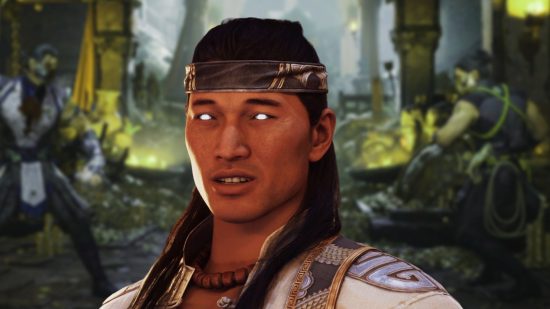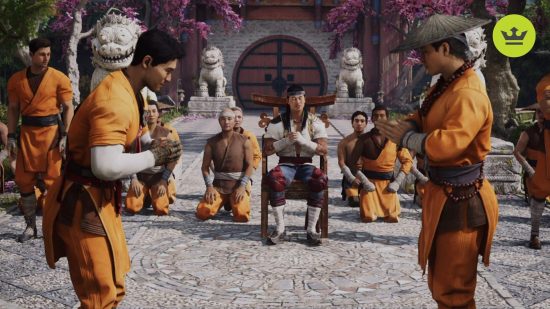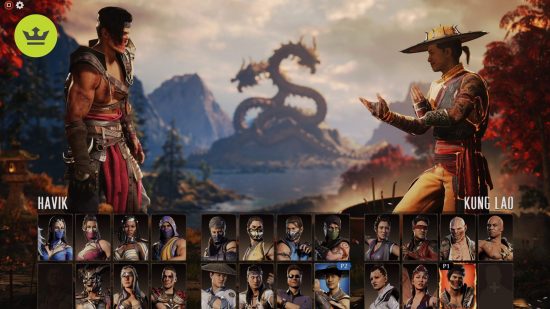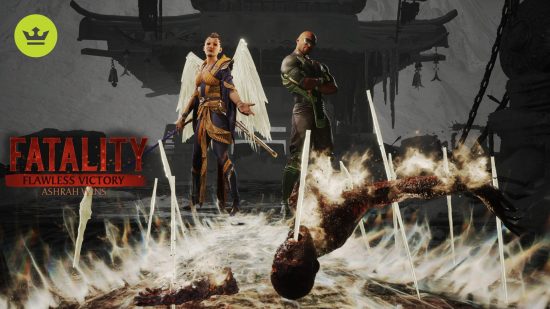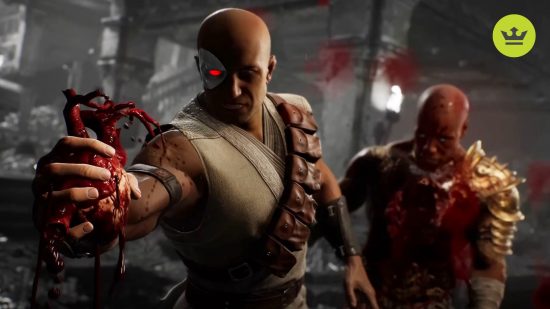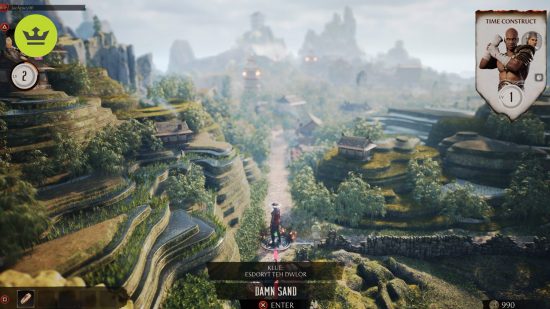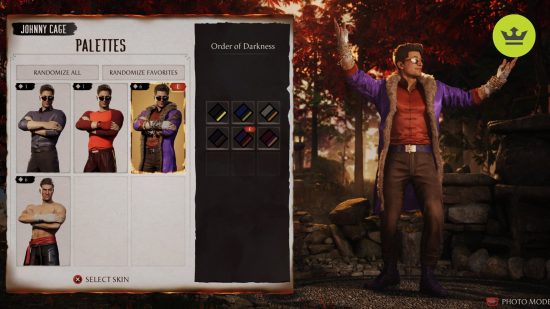Our Verdict
Mortal Kombat 1 is a reboot with a big, bloody heart. It re-tools Mortal Kombat's story and characters in creative ways, and for the most part, the combat is excellent. Unfortunately, there are some elements that feel rushed. It's still a very good fighting game, but it should have been a great one.
If there’s one thing the Mortal Kombat series is good at, it’s reinvention. It’s been a 2D fighter, a (usually bad) action-adventure game, a 3D fighter, an (excellent) beat ‘em up, and a 2D fighter again. Mortal Kombat 1 is NetherRealm Studios’ latest attempt to re-invent the series again: a full-on, lore-heavy, in-universe reboot that looks to cement its place as one of the best fighting games ever made. When the kombos are landing during its visually-glorious brawls, the Kameos are gelling with your main, and you’re immersed in its story mode, Mortal Kombat 1 feels incredible. However, for every good thing about MK1 on the PS5, it always seems like there’s always something else holding it back from true greatness.
Let’s start with what Mortal Kombat 1 excels at. This is one of the prettiest videogames – not just fighting games, mind you, videogames, full stop – that I have ever seen. The character models and backgrounds are genuinely stunning, and the first time I played through MK1’s story mode and realized that the characters I saw in the cutscenes were the exact same models that I’d be using in real-time gameplay, it took me several minutes to pick my jaw up off the floor. I don’t know what dark bargain NetherRealm struck to make the game look like this – especially the characters’ facial animations, which are some of the most realistic and impressive I have ever seen, and the lighting, which is genuinely gorgeous – but the end result is incredibly impressive.
I’m normally not one to gush about a game’s visuals, but everything from the cutscenes, to the background environments, to the incredibly gruesome Fatalities, to the character’s animations, looks incredible. MK1’s audio is also excellent. Every bone-crunching hit, squishy Fatality, and booming special effect sounds fantastic, and adds a nice bit of feedback to everything going on on-screen. When it comes to production values, NetherRealm has clearly spared no expense.
Good visuals matter, but they are arguably the least important important thing in a fighting game. Fortunately, Mortal Kombat 1 is no slouch in the gameplay department, either. In fact, this might be the best fighting system NetherRealm has ever developed. NetherRealm has excelled at making every Mortal Kombat game since MK9 play very, very differently from one another without ever losing the secret sauce (it’s blood, isn’t it? Gallons and gallons of blood) that makes the series stand out among the big three fighting game series. MK1 continues that trend.
For starters, everything – enhanced special moves, kombo breakers, and the new ability to jump cancel out of uppercuts – is governed by one meter again. Fatal Blows, MK1’s version of the X-Ray attacks that unlock when you’re at low health, are back, but they’re not invincible on start-up anymore, so they’re harder to use as reversals. There are, in a move that especially pleases yours truly, no more character variations; when you pick Scorpion, you play Scorpion, not one of three versions of him.This makes characters earlier to understand, and their kits feel better (more komplete, if you will) as a result. Wakeups work differently (and frankly better) than in MK11, and crouching jabs are now punishable on block with your own crouching jab. There’s also a new emphasis on air kombos, which can be jump-canceled after certain moves and feel fantastic to land, and add some much-needed spice to MK1’s kombo game. These are all welcome (and frankly, smart) changes that show NetherRealm was listening to the kommunity (no, I’m not going to stop. We kommit to the bit here). And that’s before we get into Kameos, MK1’s newest – and most exciting addition.
The thing you have to understand about MK1 is that it’s essentially a tag game without actually being a tag game. In addition to choosing the character you’ll play as during each fight, you’ll also choose a Kameo, a separate, second character that you can call in as an assist during kombat. Each Kameo is governed by a separate meter, and calling upon them in battle generally uses half of it, though there are some Kameos with moves so powerful (say, Goro) that use the whole thing in one fell swoop. Best of all, each Kameo comes equipped with three assist moves, at least one Fatality, and a few Brutalities, so you’ve got a few options no matter who you pick as your tag-team partner. Add in that there are 15 Mortal Kombat 1 Kameos to choose from, and you’ve really got some choices to make.
Variety’s the spice of death, but what the Kameo system really means is that you can cover for your character’s weaknesses or enhance their strengths. Here’s an example from my time with the game so far: Johnny Cage is one of my favorite characters in MK1. He’s got some sick kombos, excellent special moves, a ton of style, and a Hype meter that, when filled, can be activated to allow him to cancel his special moves into one another up to three times – literally breaking the rules of the game. If you’re a kombo fiend, lab monster, or total degenerate, like me, he’s perfect. Johnny does have one major weakness, though: none of his strings start with low attacks. He does have some: they’re just standalone moves or at the end of his strings. What’s an A-lister to do? Well, pick the right Kameo, of course. Frost’s low slide covers a lot of ground and is a great way to open people up, and Stryker has a low crowbar attack that can get the job done, too. Now I can force my opponent into some really uncomfortable scenarios, and make them respect Johnny’s low game.
Of course, different Kameos do different things. Jax, for instance, has a command grab that will scoop anybody out of the air, Sareena can extend kombos like it’s going out of style, Kung Lao can teleport you behind your foe for some tricky mix-ups or punishes, and Kano’s eye beams offer a projectile for any character who doesn’t have one – or somebody who just wants another. You can never have too many projectiles in MK. I primarily prefer 1v1 fighters, so I’m generally not big on tag games or assists. However, MK1’s Kameos gel perfectly with your primary fighter, offering uniqueness and variety without compromising what makes each character unique. Kameos feel so great, they’re making me rethink my philosophy on tag fighters…
If all that sounds complicated, it’s because it is. One of things MK1 does very well, however, is its tutorial. This thing is fantastic. It will explain the controls, attacks, defense, system mechanics, what to do when you get knocked down, what to do when you knock someone down, how to pressure your opponent, how to use Kameos, how to hit confirm, how to read frame data (which, blessedly, is available in practice mode for every character), what all of the things I just mean if you’ve never played a fighting game before, and a lot more. It’s an absolutely fantastic tutorial everybody should play, but even here there’s a caveat. Aside from Kombo Trials, which offer seven lessons per character, there are absolutely no character-specific tutorials, and some of the frame data in the training mode appears to be wrong. It’s bizarre given how good the general tutorial is.
It’s not all gore and buckets of blood, though. Mortal Kombat 1’s still got that very particular MK feel. The dial-a-kombo system it uses can take some getting used to (especially if you’re coming from something more fluid like Guilty Gear Strive or Street Fighter 6), the block button is still a weird, MK-exclusive eccentricity in the 2D space, and everything just feels a bit stiff because of the way the animations are (though MK1 feels less stiff than previous Mortal Kombat titles). Your mileage may vary, but this does add up to some characters feeling worse to play, especially when it comes to their kombo routing. Characters like Liu Kang can feel stiff and unresponsive, while Johnny Cage and Reptile often feel like they’re playing a completely different (and more enjoyable) game. This isn’t a game-breaker by any stretch – you’ll get used to it as you play and compensate accordingly – but it’s still lousy.
And the Kameos, as good as they are, also seem to have problems. Just about everybody online is using Sareena’s kombo extension abilities. Is she that much better than everyone else, or is it just early-game bandwagoning? It’s impossible to say until the kommunity has spent more time with MK1, but it is concerning.
Okay, so Mortal Kombat 1’s gameplay is good, aside from a few annoyances. What about the ways you can play it? The draw for many will be the story mode. For my money, NetherRealm makes the best fighting game story modes in the business, and MK1 is no exception. Things are a little different this time around. Following the events of MK11: Aftermath, the entire history of Mortal Kombat has been re-written. These faces might be familiar, but many of them have all-new backstories, powers, relationships with other characters, motivations, and more. MK1 picks up, in the words of Liu Kang, former creator of the universe and current God of Fire and Protector of Earthrealm, “eons” after MK11. This new timeline is a much nicer place to be than the old one. Outworld is ruled by the benevolent Queen Sindel, things in Earthrealm seem to be going pretty good, and yeah, there’s still a Mortal Kombat tournament, but it’s more of a friendly competition for honor, glory, and bragging rights between neighbors than an all-out brawl where people are brutally murdered and losing too many times means your realm gets invaded by dudes with names like Shao Kahn.
Things start out pretty peacefully, with Liu Kang recruiting the usual suspects to represent Earthrealm. After a few, mostly chill and fun chapters where our champions grow, bond, become better people, and kick ass in the name of Earthrealm while World’s Best Fire God Liu Kang looks on like the proudest papa you ever did see, NetherRealm ratchets up the stakes and things get pretty crazy.
As fun as the realm-ending stakes are, what I most enjoyed was seeing these new takes on old characters. In the past, characters like Baraka, Reptile, and Mileena have generally been relegated to the roles of low-rent henchmen or mustache-twirling villains, but they’re much more nuanced characters here, with real backstories, trauma, and desires, and I genuinely enjoyed spending time with them. Everyone on the Mortal Kombat 1 roster gets a chance to shine, but it’s particularly great to see characters who have been previously underutilized get their day in the sun. MK1 doesn’t do much to iterate on the formula laid down by previous NetherRealm fighters, but this is a well-produced, well-written, and well-acted story that is often genuinely funny and heartwarming had me invested in the characters and plot while acknowledging how silly it all is and including plenty of easter eggs, references, and gags for long-time fans. That’s a hard line to walk, but MK1 nails it.
My only complaint with the story mode is that by the time you learn a character’s moves, you’re on to the next one, and you never return to anyone you’ve previously played. That means spending a lot of time in the move list learning strings and specials, trying them out, and seeing what works, and just as you feel comfortable, it’s onto the next character. It would be nice if NetherRealm had optional tutorials or videos showing you how to play each character when you go to them, but I also understand not wanting to break up the pacing. All told, however, the campaign takes about six hours and is an absolute blast.
The other big single-player mode is Invasions, which combines MK’s Krypt, Towers of Time, and Konquest mode together into a single thing that plays out as a board game with some light RPG elements. You move your character around the board, and each space has a theme fight. A space like Prized Princess will have you fight Kitana, while one marked Kung Wow has you battle a superpowered Kung Lao who you have to beat twice. Clearing a space opens the way forward, gets you some experience to level up your characters, and drip-feeds you some rewards as you go. There are also mini-games like Test Your Might, Survive, and the odd themed Tower, where losing a single fight will send you back to the bottom. You also might get ambushed between spaces or have to find keys to open doors.
Sounds fun, right? It should be, but disappointingly, it’s mostly a slog. These fights are incredibly repetitive – being in an area means you often fight different variations of the same characters over and over again – and almost every fight is a pushover. I played Johnny Cage, Reptile, and Scorpion in my time with Invasions, but I mostly did the same things – using the same launcher strings over and over and over again to knock them up in the air and land a big kombo. Rinse and repeat. And you know what? It worked.
NetherRealm is trying here. The boards themselves are all themed differently and quite good, and there’s a lot going on under the hood if you want to engage with it. You can level characters up, equip Talismans that allow you to use special attacks in kombat, and have Relics with positives and negatives that affect your playstyle. Unfortunately, you can ignore most of this stuff until the later boards, and even when you have to engage with it, it feels more like a chore you complete to unlock cool cosmetics – outfits, weapons, masks, colors, etc – for your character. I don’t mind the odd gimmick fight, but given that MK1 feels best when they’re not there, it’s not great that you have to do so much of this stuff to progress. More annoyingly, the mode clearly isn’t designed for something that isn’t a controller (there is essentially no way to use Talismans on a fightstick or leverless controller because they are mapped to the right analog stick, and there’s no way to remap them), and once you leave the tutorial stage (a wonderfully rendered version of Johnny’s house), you can never go back. If you missed something, tough luck.
There’s also your standard character and survival Towers to complete, and timed Towers you can run through in Invasion mode, but otherwise, that’s about all there is to MK1’s single-player content. If I’m being honest, I would rather have MK11’s Krypt than any of this because it was different and fun. It’s definitely Mortal Kombat 1’s biggest disappointment.
The upside is that MK1 rewards you for playing with each character. The more you play, the more character experience you get, and the more you unlock. It’s kind of like a free Battle Pass for each kombatant and Kameo fighter, and there’s a ton here to unlock – Brutalities, taunts, skins, colors, profile customization items, and even Fatalities. It’s a nice system, but it does have its drawbacks. First, some Kameos are locked behind leveling up your overall player level – which you’ll get just by playing – which isn’t great. Secondly, it takes absolutely forever to unlock everything for a character. And thirdly, even if you do figure out a Fatality’s button input before you unlock it properly, the game doesn’t give it to you in your move list. In the old days, it would have. Here, you have to keep playing. You can spend 1,000 of the Koins you unlock by playing these modes to unlock random items from the Kollection – think character art, stage art, and music – at the Shrine if you’d rather not deal with some of the grind, but the Shrine animation takes absolutely forever to complete and longer to reset. No matter what you do, unlocking things is a slog.
Finally, there’s the online, which is, you guessed it, also full of caveats. First things first: MK1 uses rollback netcode, and matches are buttery smooth even across great distances. King of the Hill is back, and there’s also Kombat League, which is good at matching you up with opponents around your skill level and provides seasonal cosmetic rewards for achieving higher ranks. All good stuff.

The devil is in the details. First, there’s no option to matchmake while you’re playing another mode, not even training, which basically every other fighter has at this point. This omission is frankly unacceptable. Secondly, there’s no cross-play functionality, at least right now. NetherRealm promises that it’s coming, but we have no idea when. Thirdly, when you make a custom room, there’s no option to make one with multiple slots so multiple matches can happen at the same time, and if you try to join or spectate a match that has already started, you’re taken to a black screen with the MK dragon logo and a pair of health bars you get to watch decrease. You don’t get to see the actual game until the next match – something several other fighting games allow you to do. A lot of these problems carry over from MK11. These limitations were understandable in 2019. In 2023, however, they’re inexcusable. NetherRealm used to be one of the leaders when it came to online fighting games. Now, it feels like the rest of the genre has passed it by.
And that’s ultimately how I feel about a lot of MK1. It feels great to play, the new systems add a ton of depth, and the story mode is best-in-class. Absolutely everything else just simply isn’t up to snuff or comes with a huge caveat. Invasions are a good idea, but they get old fast. The tutorial is great, but there are very few tools for learning each individual character. The online play works great, but it’s lacking features that are now genre standards. It looks great, but unlocking cosmetics, Brutalities, and Fatalities are a chore. Players have already found substantial bugs in the game’s input reader, which is a big deal in a genre where precision is king. And on and on it goes.
In many respects, Mortal Kombat 1 feels like a game that was rushed out the door so investors could crow about quarterly earnings rather than a game that was released because it was finished. That isn’t NetherRealm’s fault, and it has done a lot of great work in MK1. The fighting system might be the best it’s ever been, Kameos are a fantastic addition to the game, it has a great cast that brings in well-known characters and some forgotten faces from the 3D games, the story mode is fantastic, it looks and sound incredible, and there are even a lot of great accessibility options, like a screen reader. But everything else comes with a caveat. Don’t get me wrong; I’ve spent over 25 hours playing Mortal Kombat 1 for this review, and I plan to spend hundreds more. This is still a very good fighting game that’s worth playing, but it should have gone down as one of the all-time greats.
